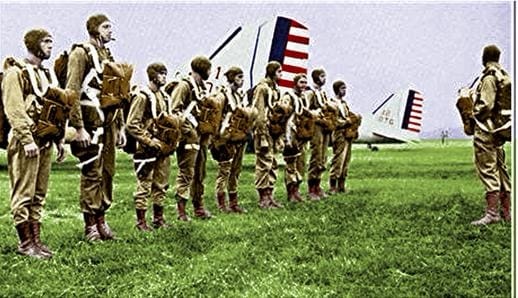
The first official US military parachute jump was on 16 August, 1940. Seen above are members of the Parachute Test Platoon.

The first official US military parachute jump was on 16 August, 1940. Seen above are members of the Parachute Test Platoon.
FUERTE MILITAR DE TOLEMAIDA, Colombia — Nestled in the heart of Colombia’s Andes mountain range, approximately 75 miles south of Bogota, roughly 300 soldiers from the U.S. and Colombian armies forged partnerships during the bilateral airborne infiltration exercise, Hydra III 2024, held from July 28 to August 1, 2024, in Fuerte Militar de Tolemaida, Colombia.
A U.S. Army South-led exercise, HYDRA 24, formerly known as Dynamic Force Employment, is an agreed-to-action between the partner nations and the third iteration of its kind.
Participating units included the 2nd Battalion, 508th Parachute Infantry Regiment, 2nd Brigade Combat Team, 82nd Airborne Division; the Colombian Army Battalion of Counter Narcotics; the 7th Special Forces Group, the 1st Security Forces Assistance Brigade and support personnel from the ARSOUTH command.
“It is no secret that around the globe it is growing more important with each passing month and year that while we are experts in some aspects we have so much to learn from our partners around the world,” said U.S. Army Maj. Adam Amor, 2nd Battalion, 508th Parachute Infantry Regiment operations officers and lead officer in charge of the 82nd Airborne Division paratroopers participating in HYDRA 24.
“The reality is in today’s battlefield partner force integration is the standard, it isn’t just a one-off opportunity and it is not just something we only do for training exercises but everywhere that we go around the globe we are going to be shoulder to shoulder with another partner nation,” said Amor.
The exercise aimed to enhance the technical, procedural and interoperability between Colombian and U.S. paratroopers. This demonstrates the U.S. Army’s ability to rapidly and strategically employ forces in the U.S. Southern Command area of responsibility.
For many of the paratroopers, it was their first time integrating and interacting with a partner force.
“I was very impressed that everybody was able to expand and work out the language barriers to make the operations a success, in addition to some of our ad hoc translators who stepped up to help integrate with our partners,” said Amor.
“We also learned that we have different methods of executing higher operations and battle tracking across the area, but our paratroopers could easily integrate with their partners even despite the language,” said Amor.
Amor stressed the importance of learning to synchronize planning efforts to facilitate battlefield operations anywhere in the world.
With a focus on pre-deployment operations, HYDRA 24 allowed U.S. Army Soldiers to enhance their agility in a new training domain alongside partner forces. This collaboration further improved interoperability and prepared them for success in competition, crisis and conflict.
“The Colombian Counter Narcotics Battalion 1 has a specific mission and we also have a specific mission set with a global focus,” said Amor. “Because of this we were able to share lessons with airborne operations and learn how they execute operations that may be more localized using different types of aircraft and different types of jungle movements.”
Amor added that he was impressed with the initiative of the Colombian Army’s company commanders and appreciated their hospitality and capabilities, which facilitated the exercise.
“The Colombian Army is currently working on becoming interoperable with other armies worldwide. This exercise represents a significant step forward in that process,” said Colombian Army Lt. Col. Bayardo Pena, senior observer and operations officer in charge for the Colombian Army.
“The U.S. Army has been supporting us for many years. The fact that we are conducting this exercise is going to strengthen and increase our partnership for the future,” said Pena.
Pena stressed the importance of both armies being able to conduct the planning process, execution of the maneuver, understand each other’s doctrine, and execute an exercise.
“The U.S. Army has a world standard in terms of doctrine and it is going to help us standardize our processes too,” said Pena. “I am proud of our soldiers and how they conduct themselves with other armies like the U.S.”
The U.S.-Colombia partnership remains one of the most vibrant and mutually productive relationships in the Southern Hemisphere. SOUTHCOM and U.S. Army South bilateral exercises aim to demonstrate the United State’s commitment to the region and its citizens.
The exercise culminated in a distinguished visitor day, foreign airborne wing exchange ceremony and remarks from the U.S. Army South Commanding General, Brig. Gen. Phil Ryan.
“Today’s event goes beyond just tactical and operational interoperability, although that is crucial, what truly matters is the human connections formed between all of you,” said Ryan during the foreign wing exchange ceremony. “These bonds are key to safeguarding our shared values of democracy and human rights, and to preserving our way of life in the Western Hemisphere.”
Prior to the exercise, the two armies synchronized tactics, techniques and procedures, medical and communication rehearsals to ensure seamless integration throughout the combined training exercise and the multinational airborne assault.
“Our goal is to enhance our interoperability so we can operate seamlessly together as one multinational force whenever needed,” said Ryan. “Embrace this shared experience and remember that, despite our different backgrounds and languages, we are united by your common identity as paratroopers – Defense and Fraternity!”
By MAJ Nadine Wiley De Moura
PACIFIC OCEAN — West Coast-based Naval Special Warfare (NSW) operators participated in fleet interoperability training off the coast of Southern California June 24, focusing on increasing warfighting capabilities in the maritime domain.
The training involved aircraft from Commander, U.S. Naval Air Forces and the Los Angeles-class attack submarine USS Greeneville (SSN 772), assigned to Commander Submarine Squadron 11 (CSS-11).
“This training opportunity provided the submarine warfighters aboard USS Greeneville the opportunity to practice a unique capability,” said Capt. Kenneth Douglas, Commander, Submarine Squadron 11. “Expanding joint interoperability capabilities effectively demonstrates our asymmetric advantage on and under the world’s oceans and I look forward to continued training events with our Naval Special Warfare operators.”
During the training, Naval Special Warfare (NSW) operators performed a military freefall and conducted an airborne drop of combat rubber raiding crafts (CRRC) off the coast of Southern California. Following this, the NSW operators rendezvoused with Greeneville at a designated location before returning to shore.
“Undertaking an operation of this caliber highlights the indispensable role that NSW and the submarine force play within the joint force,” said Capt. Blake L. Chaney, Commander, Naval Special Warfare Group 1. “By synchronizing our operations, activities and investments, we not only bolster fleet lethality but also provide substantial value in securing access to either denied or contested areas.”
Engaging in ongoing training with Naval Special Warfare and Commander Submarine Squadron 11, ensures that the U.S. Naval force is well-prepared to tackle the challenges of a dynamic and competitive maritime environment.
CSS-11 is home to five Los Angeles-class fast attack submarines, which are capable of supporting various missions, including: anti-submarine warfare; anti-ship warfare; strike warfare; and intelligence, surveillance, and reconnaissance.
Naval Special Warfare is the nation’s elite maritime special operations force, uniquely positioned to extend the Fleet’s reach and gain and maintain access for the Joint Force in competition and conflict.
By Petty Officer 1st Class Alex Perlman And Petty Officer 1st Class Alex Smedegard
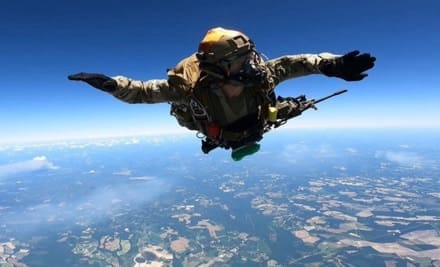
FORT LIBERTY, N.C. — Airborne and special forces Soldiers at Fort Liberty are testing the latest small arms weapon sights.
The 82nd Airborne Division, joined by the 3rd and 10th Special Forces Groups, are in the final stages of testing the Family of Weapons Sights – Individual, or FWS-I, for static line and military free fall airborne infiltration.
The FWS-I program will provide Soldiers with thermal enablers for individual weapons.
“The FWS-I gives Soldiers the capability to see farther into the battlefield, increase surveillance and target acquisition range, and penetrate day or night obscurants,” said Lashon Wilson, a test coordinator for Project Manager Soldier Lethality.
“American paratroopers and special operations Soldiers are renowned for attacking when and where least expected and almost exclusively at night,” said Staff Sgt. Derek Pattle a test NCO with the Airborne and Special Operations Test Directorate, also known as ABNSOTD.
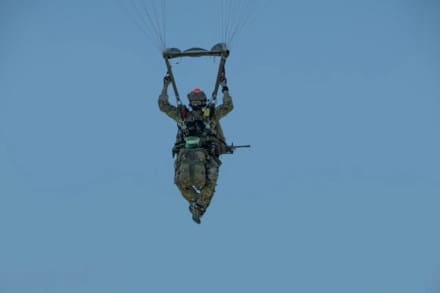
“Conducting forced entry operations during daylight hours leaves paratroopers exposed to enemy ground fire and counterattack during airborne assault,” he added.
“That’s why mastering night vision devices and targeting systems is a critical skill for Army paratroopers and Special Operators and vital to mission accomplishment during forced entry parachute assault.”
According to Capt. Joseph Chabries, a plans officer at ABNSOTD, the core question for military equipment employed by Army paratroopers and special operations regarding is in its survivability.
“’Can the system survive airborne infiltration?’” said Chabries.
“Individual paratroopers as well as vehicles and cargo delivery systems are bristling with technology, which can at times be fragile,” he added.
“Ensuring these systems are both suitable and effective for issue to airborne forces often requires a more technical approach.”
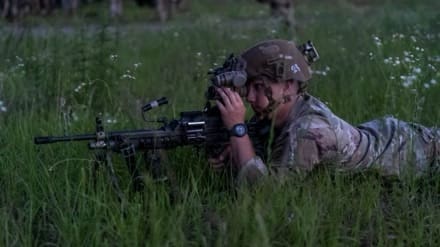
Staff Sgt. Dalton Carter, a weapons squad leader with 2nd Brigade, 82nd Airborne Division said, “I feel as if this is a step in the right direction for army night vision and lauded the operational features the FWS-I can provide his squad.”
The FWS-I test also exposed many veteran paratroopers to operational testing for the first time.
Sgt. David Brown, a fire team leader in Bravo Company, 1-325 Airborne Infantry Regiment, serving as a test participant during static line testing, said, “I feel like the FWS-I can be a real force multiplier for key leaders during hours of limited visibility or when the battlefield might be obscured.”
During post-drop operations, jumpers assembled for accountability and to ensure all FWS-Is were fully mission capable by performing a system functions check and collimation using the mobile boresight collimation station, which is used to evaluate the bore sight retention and repeatability of the FWS-I before and after static line and military free fall infiltration.
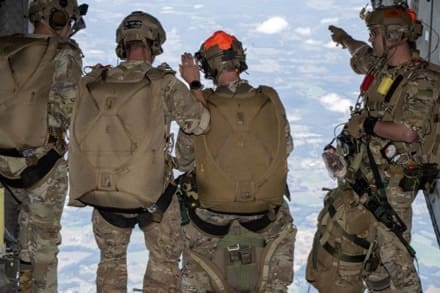
The data from the mobile boresight collimation station allows the test team to determine if and how much the boresight reticle on the FWS-I was moved or displaced due to any shock induced from exiting the aircraft, the opening of the parachute canopy or landing on the ground.
“ABNSOTD is one of the few organizations in the Department of Defense that maintains a bore sight collimation capability and the only mobile system of its kind,” said Mr. Jacob Boll, ABNSOTD’s operational research analyst.
The ABNSOTD instrumentation section is charged with maintaining and employing this unique capability and trained extensively to conduct post-drop weapons testing before beginning operational testing of FWS-I.
Maj. Joshua Cook, deputy chief of ABNSOTD’s Test Division described the importance of testing and how it plays into the future of technology in warfare.
“Operational testing is about Soldiers and ensuring the systems developed are effective in a Soldier’s hands and suitable for the environments in which they train and fight,” Cook said.
By Mr. Mike Shelton, Test Officer, Airborne and Special Operations Test Directorate, U.S. Army Operational Test Command
AUSTIN—April 17, 2024— The much-anticipated documentary “Triple 7: They Said It Couldn’t Be Done,” directed and produced by Dan Myrick (“The Blair Witch Project”) and produced by Kristian Krempel, is set to premiere in five cities in May. The film follows a team of nine former U.S. and Canadian special operations service members as they attempt to achieve skydiving’s most elusive feat, the Triple 7— seven skydives on seven continents in seven days. Spearheaded by retired Navy SEAL Mike Sarraille, the film aims to raise $7 million for Folds of Honor.
“Triple 7” will roll out the red carpet between May 11-16 in New York, Tampa, Austin, Dallas, and Los Angeles, respectively. Expedition members and filmmakers will be available to the media in the days leading up to the New York premiere and at each city’s red-carpet event.
“The road to this theatrical release for ‘Triple 7’ has been a deeply personal and collective commitment at Legacy Expeditions. Spanning three years, the endeavor of the expedition and creating the documentary was significant, but the cause—to etch the legacy of our fallen into the annals of history—made every challenge worth facing,” said Sarraille. “The excitement of the adventure and the emotional depth of our shared stories will, I hope, touch the hearts of viewers, both through laughter and tears, reminding us all to never forget and to forever honor those who gave everything.”
Premiere Dates and Cities: Tickets may be purchased at legacyexpeditions.com.
• New York City: May 11 at 5:30 and 7:30 p.m. EDT
LOOK Dine-In Cinemas W57- 657 W. 57th St., New York, NY 10019
• Tampa: May 13 at 7:30 p.m. EDT
The Tampa Theatre- 711 N. Franklin St., Tampa, FL 33602
• Austin: May 14 at 7:30 p.m. CDT
Alamo Drafthouse, South Lamar- 1120 S. Lamar Blvd., Austin, TX 78704
• Dallas: May 15 at 7:30 p.m. CDT
The Texas Theatre- 231 Jefferson Blvd., Dallas, TX 75208
• Los Angeles: May 16 at 7:30 p.m. PDT
Landmark Theaters Sunset- 8000 W. Sunset Blvd., Los Angeles, CA 90046
“When approached by Mike to document their world record attempt with the aim of raising $7 million for Folds of Honor, I saw an opportunity beyond mere spectacle,” said Myrick. “It became a personal mission to delve into the motivations and profound purpose driving this group of individuals often misunderstood in contemporary society. What unfolded was a profound exploration of a multi-faceted collective: highly skilled and committed soldiers intertwined with heartfelt, humorous, and contemplative human beings.”
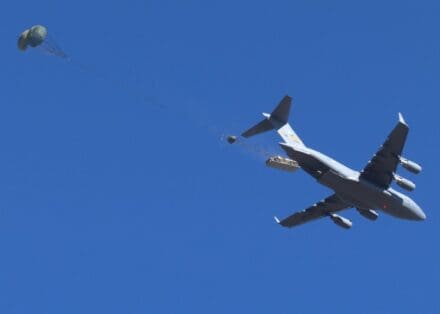
FORT LIBERTY, North Carolina – Airborne logistics Soldiers here just completed airdrop testing of the Army’s newest Family of Medium Tactical Vehicles.
Troops of the 151st Quartermaster Company, 189th Combat Sustainment Support Battalion, 82nd Airborne Division Sustainment Brigade, put the vehicles through a series of Low Velocity Airdrop configurations.
The M1093A2 FMTV is a fleet of vehicles set to modernize the Army’s capabilities with its advanced design, compared to its aging predecessor, the Light Medium Tactical Vehicle.
Assistant Program Manager Mr. Tom McDaniels, U.S. Army Program Executive Office, Combat Support & Combat Service Support, emphasized the strategic importance of the M1093A2 FMTV.
“This Army program delivers an airdrop-capable vehicle that excels in multiple mission roles, offering protected, sustained, and networked mobility for personnel and payloads in a wide range of military operations,” he said.
The series of tests at Fort Liberty kicked off with comprehensive Operator’s Training (OT) and New Equipment Training (NET) delivered by expert trainers from Oshkosh, the vehicle manufacturer.
The training ensured the paratroopers were fully equipped with the knowledge and skills to operate and maintain the vehicle throughout the airborne testing phase.
Staff Sgt. Shahbaz Shakil Ahmed, a motor transport operator from the 151st Quartermaster Company, explained the rigorous testing process as the Soldiers demonstrated exceptional skill and precision by successfully rigging, airdropping, and recovering the FMTV, followed by thorough rigorous road tests to validate its operational readiness and full mission capability.
He said he was eager to transition to the new FMTVs, highlighting the significant improvements in survivability, payload capability, and his pride in contributing to the vehicle’s airdrop rigging development.
The testing agenda included low-velocity airdrops and subsequent road tests to assess the vehicle’s maximum load capacity, all critical steps towards achieving final airdrop certification from the Natick Soldier Research, Development, and Engineering Command.
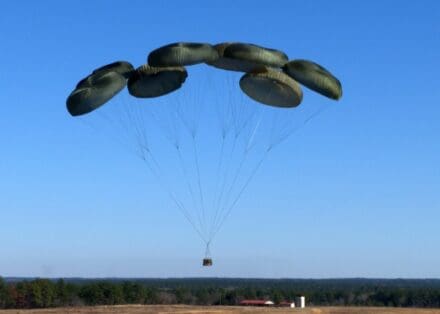
Sgt. 1st Class. Dao Le, a project NCO with ABNSOTD’s Aerial Delivery Rigging Branch, said the testing process is meticulous.
“Every piece of equipment Soldiers use has been independently tested and evaluated to meet current and future Army needs and requirements,” he said.
Mr. Aaron Clark, a military test plans analyst with ABNSOTD involved in Low Velocity Airdrop FMTV testing, captured the essence of the effort.
“Operational testing is about Soldiers,” he said. “It’s about ensuring the systems we develop are effective in a Soldier’s hands and suitable for the environments in which Soldiers train and fight.”
The airdrop missions were executed using U.S. Air Force C-17 and C-130 aircraft, which reflect a significant advancement in military logistics and capability, setting a new standard for operational excellence and readiness, according to Clark.
“Operational testing is OTC’s opportunity to contribute to readiness; anything less compromises the Army’s ability to provide the forces that fight and win the nation’s wars,” Clark added.
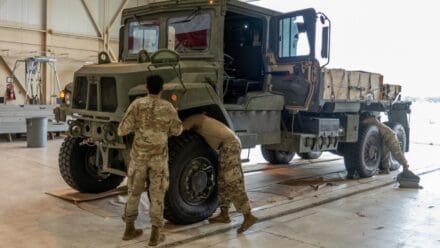
Mr. Bill Slaven, branch chief of ABNSOTD’s Test Division, shed light on integration of systems under examination into actual missions and training agendas of test units.
“Unit commanders get an early opportunity to evaluate new systems, potentially influencing modifications in operational tactics and military doctrine,” he said.
“The unique aspect of these tests is that they are led by the units themselves, ensuring a seamless melding of control within authentic operational environment scenarios.”
According to Maj. Joshua Cook, chief of the ABNSOTD’s Test Division, every piece of equipment Soldiers use has been independently tested and evaluated to meet current and future Army needs and requirements.
“We test and assess Army, Joint, and Multi-service airborne and airdrop-related warfighting systems in realistic operational environments by using Soldiers to determine whether the systems are effective, suitable, and survivable,” he said.
“The commitment to testing and assessing equipment aims to ascertain their effectiveness, suitability, and survivability.”
By Mr. James Cochran and Mr. Aaron Clark, Military Test Plans Analysts, Airborne and Special Operations Test Directorate, U.S. Army Operational Test Command Public Affairs
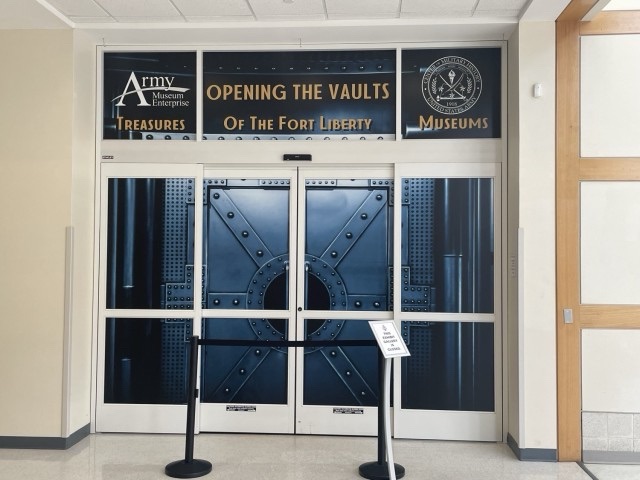
WASHINGTON — On March 14th, 2024, the U.S. Army Special Operations Museum will launch an exciting new exhibit, “Opening the Vaults” at Fort Liberty, North Carolina, formerly Fort Bragg.
Opening The Vaults: Treasures of the Fort Liberty Museums is a temporary exhibit that will present rare and never-before-seen artifacts from the Fort Liberty Museums and historical holdings.
The exhibition is a collaborative effort with the John F. Kennedy Special Warfare Museum, 82d Airborne Division War Memorial Museum, U.S. Army Reserve Command History Office, and the 503d Military Police Battalion (Airborne).
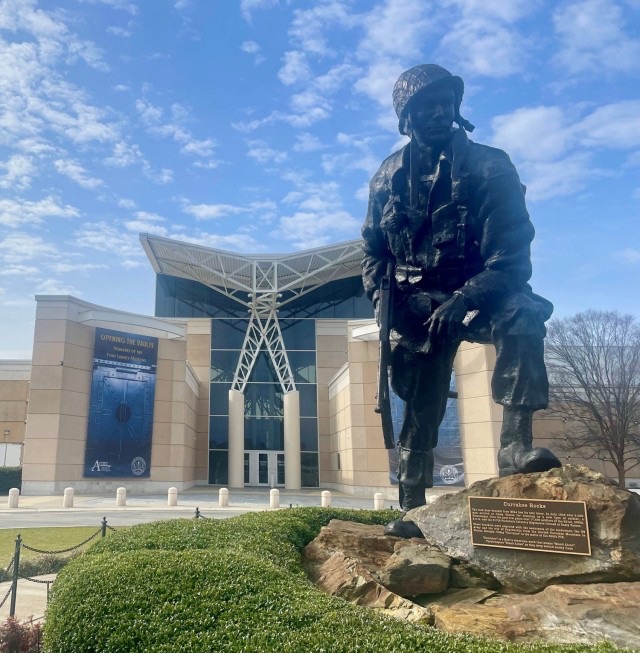
ASOM, constructed in 2000, is the first U.S. Army Museum built outside the perimeters of an Army installation. Artifacts from the Fort Liberty Museum Enterprise as well as assets from the U.S. Army Center of Military History (John F. Kennedy Special Warfare Museum) will be housed together and accessible to the public, in the heart of downtown, Fayetteville, North Carolina.
Jim Bartlinski, Director of the Fort Liberty Museum Enterprise, said, “we thought that this would be a good opportunity not only to showcase rare artifacts, and never before seen artifacts, that we have here at ASOM, but also to give folks who necessarily don’t know about the museums on Fort Liberty the chance to see what those museums offer.”
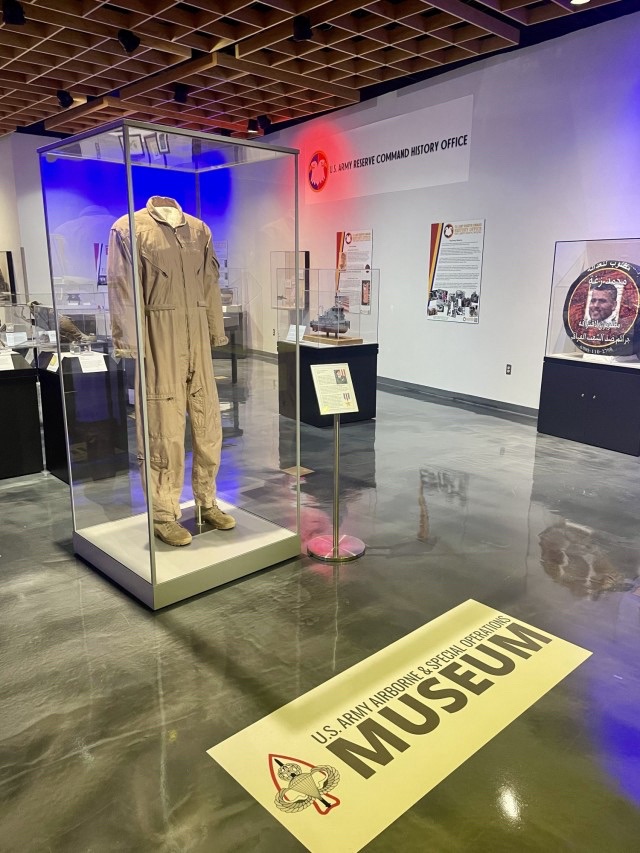
This exhibition tells the story of the Army Reserve, Special Forces, and the 82d Airborne Division. “So, it is a great collaborative effort for all of us.”
Historical panels were designed for each museum’s section by the John F. Kennedy Special Warfare Museum. The 503d Military Police Battalion, the only airborne military police battalion in the U.S. Army provided uniformed mannequins to “guard” the vault, while drawing in visitors to the exhibit.
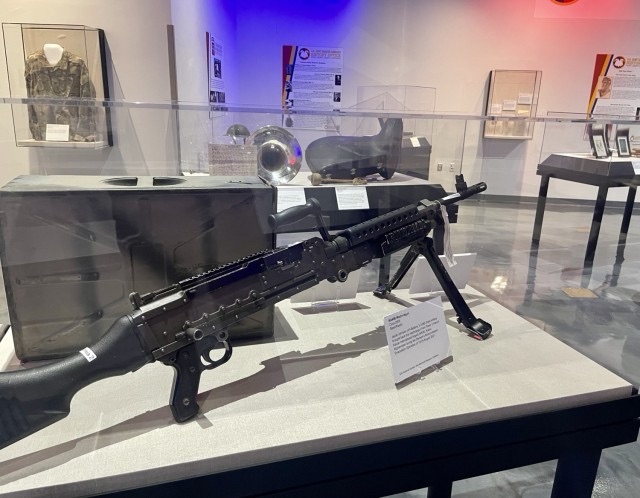
The exhibit will also feature a “Seek and Learn” activity geared towards interacting with children to learn about the history of the U.S. Army, developed by ASOM’s Volunteer Coordinator, Laura Monk.
ASOM Curator, Jimmie Hallis, said, “The exhibit is a first of its kind at the Fort Liberty Army Museum Enterprise.”
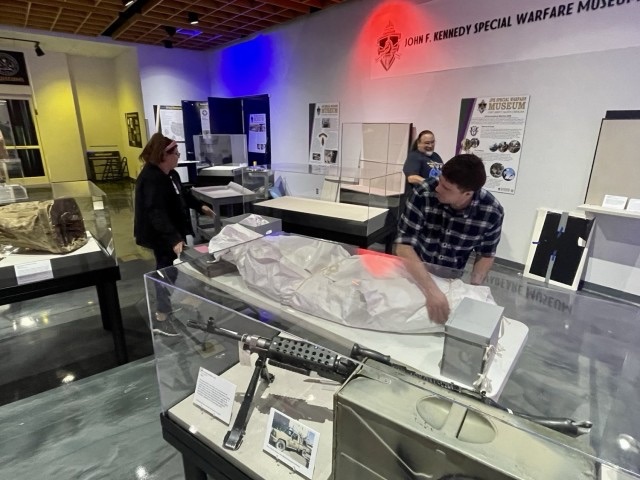
“Everyone (involved in the exhibition) jumped right on board with it. Up until the artifact installation dates, I really didn’t even know what the other museums would bring. The selection of artifacts run the history realm, from the Civil War to the Global War on Terror, there is something for everyone to see,” Hallis said.
To see the exhibit, visit the U.S. Army Special Operations Museum web page for location and operating hours. Go to: history.army.mil and click on the Museums tab.
Story by CPT Janeen R. Phelps
Photos by James Bartlinski
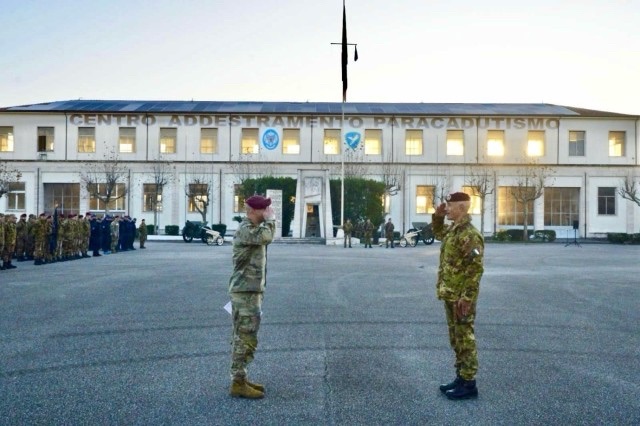
VICENZA, Italy – Few achievements stand out for a paratrooper as distinctly as earning foreign jump wings. U.S. Army Sgt. Mathew Pous, a paratrooper with 2nd Battalion, 503rd Infantry Regiment, 173rd Airborne Brigade, took this one step further, etching his name into history as the first ‘Sky Soldier’ to attain the title of Italian Jumpmaster.
Pous completed the Italian Jumpmaster School Dec. 18, 2023, in Pisa, a short distance from the city’s famed leaning tower.
The Sky Soldiers of the 173rd, forward-stationed in Vicenza, Italy, routinely conduct airborne operations alongside their Italian paratrooper counterparts of the Folgore Brigade, but Pous is the first to complete the rigorous Italian school. Paratroopers who successfully pass the course are certified to safely lead an airborne operation in the Italian Army.
“I’m extremely proud to have graduated from the Italian Jumpmaster Course,” said Pous. “Being the first from the 173rd Airborne Brigade and the third overall from the U.S. Army is an honor.”
As with its Italian counterpart, the U.S. Army Jumpmaster School is notoriously difficult. Candidates must memorize a series of intricate parachute inspection sequences to ensure paratroopers are safely rigged into their harness and able to exit the aircraft safely mid-flight.
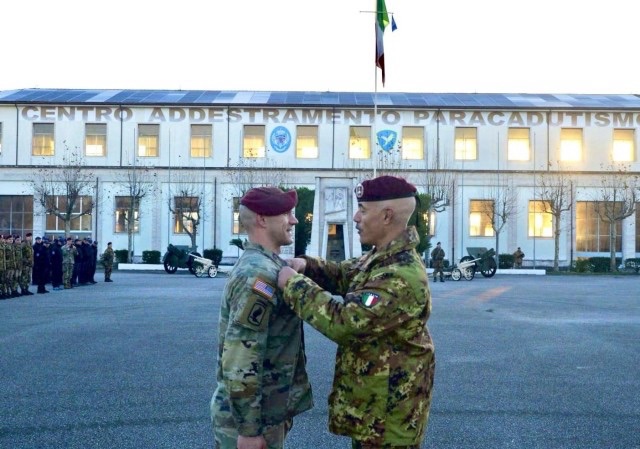
“Immediately, they were surprised at how good my Italian was,” said Pous. “That I even use Italian slang and lingo to fit in. They appreciated my enthusiasm and respect for their culture, which lifted any barriers or reservations they had prior to meeting me.”
Pous shared that he started learning Italian at the dining facility in Vicenza on base, asking the Italian cooks how to say ‘eggs sunny side up’ and other words.
“I think it’s an added value to open up to another culture and understand their point of view and lifestyle,” he said.
After about a year of practice, he felt sufficiently fluent to tackle the difficult course.
The Italian Jumpmaster School emphasizes adaptability and cross-cultural collaboration. Soldiers are trained to execute their duties seamlessly together with international partners, reflecting Italy’s commitment to participating in multinational operations.

“Attending the school is not only about being a Jumpmaster and knowing how to speak Italian, but being a representative of the U.S. Army,” said Pous.
Prior to his experience in Pisa, Pous completed the U.S. Army Jumpmaster course just three months earlier, Sept. 18, 2023, after completing 35 jumps as a paratrooper. To assist himself and others with the finer details of airborne operations, Pous video documented his progress through the Italian course, as well as several of his multinational jumps.
He shared that one of the key differences between the U.S. and Italian schools lies in what each course emphasizes the most.
“U.S. Jumpmasters have a safety who swings the static lines and that is their primary focus as paratroopers exit the aircraft,” said Pous.
Pous explained that, instead of safeties, Italian Assistant Jumpmasters swing the static lines, then observe each jumper exit the aircraft, checking that the light is still green. Only then, in one fluid motion, does the assistant reach for the next jumper’s static line.

“It was challenging because I wasn’t used to that. I had to learn a new way and build new muscle memory,” said Pous.
Another difference Pous noted was both U.S. primary and assistant Jumpmasters jump out of the aircraft. In the Italian army, the Jumpmaster and assistant remain aboard the entire time, landing with the aircraft at the end of the airborne operation.
“Also, American pre-jump includes four pages of text that must be recited verbatim, whereas the Italian pre-jump consists of a number of bullet points you must convey, but you have the freedom to explain it in your own words,” said Pous. “The advantage is that Jumpmasters can emphasize certain parts in more detail if needed. In this way, jumpers are more attentive when they know something new might be shared.”
Both schools were very professional and meticulous, he added.
Over the three-week course, Pous successfully completed five different Jumpmaster duties, all conducted in Italian. He also served as the Jumpmaster to Italian airborne students, helping them graduate from airborne school.

“My best memory was probably having coffee right after morning formation every day. It was like a ritual,” said Pous. “Everyone would go, students and instructors alike. As their guest, they never let me pay for my own coffee and brioche!”
The morning coffee ritual served as a moment to start the day slowly, said Pous, talking about everything from the course to food to culture, vacation destinations and history.
But the course itself was all business, with the “difficulty level super high but achievable,” according to Pous. “I liked that they work hard and take their job seriously. They’re experts for sure.”
Pous’ graduation ceremony offered a glimpse into the close cooperation between the U.S. and Italian militaries.
“We know that it is an honor for him to graduate our Italian Jumpmaster School,” said Italian Army Col. Antonio D’agostino, commander of Centro Addestramento Paracadutismo, the Italian airborne school in Pisa. “Just know that it is also an honor for us, as Italians, to present this diploma to him as a representative of the United States of America and the U.S. Army.”

The motivation to excel is deeply ingrained in the ethos of airborne units, where precision and efficiency can be a matter of life and death.
“Sgt. Pous is a great example of someone who takes his job seriously and recognizes our role as ambassadors in a foreign country,” said U.S. Army Lt. Col. Sheldon Broedel, commander of 2nd Bn., 503rd Inf. Regt. “He was motivated to learn Italian, forged many lasting relationships along the way, and successfully represented the U.S. Army in earning Italian Jumpmaster status.”
Pous said the next stop for him might be U.S. Pathfinder School or Air Assault School because he would like to complete the circle on his airborne knowledge. He also will soon complete a divemaster course on his own time in Padova, Italy.
“My next goal would be to attend French Jumpmaster School since I also speak French,” he said. “But that’s going to take some coordination.”
For more information about the 173rd Airborne Brigade, visit www.skysoldiers.army.mil
By MAJ Joe Legros